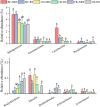Differential effects of cow dung and its biochar on Populus euphratica soil phosphorus effectiveness, bacterial community diversity and functional genes for phosphorus conversion
- PMID: 37780507
- PMCID: PMC10538999
- DOI: 10.3389/fpls.2023.1242469
Differential effects of cow dung and its biochar on Populus euphratica soil phosphorus effectiveness, bacterial community diversity and functional genes for phosphorus conversion
Abstract
Introduction: Continuous monoculture leading to soil nutrient depletion may cause a decline in plantation productivity. Cow dung is typically used as a cheap renewable resource to improve soil nutrient status. In this study, our purpose was to compare the effects of different cow dung return methods (direct return and carbonization return) on soil microbial communities and phosphorus availability in the root zone (rhizosphere soil and non-rhizosphere soil) of P.euphratica seedlings in forest gardens and to explore possible chemical and microbial mechanisms.
Methods: Field experiments were conducted. Two-year-old P.euphratica seedlings were planted in the soil together with 7.5 t hm-2 of cow dung and biochar made from the same amount of cow dung.
Results: Our findings indicated that the available phosphorus content in soil subjected to biochar treatment was considerably greater than that directly treated with cow dung, leading to an increase in the phosphorus level of both aboveground and underground components of P.euphratica seedlings. The content of Olsen-P in rhizosphere and non-rhizosphere soil increased by 134% and 110%, respectively.This was primarily a result of the direct and indirect impact of biochar on soil characteristics. Biochar increased the biodiversity of rhizosphere and non-rhizosphere soil bacteria compared with the direct return of cow dung. The Shannon diversity index of carbonized cow manure returning to field is 1.11 times and 1.10 times of that of direct cow manure returning to field and control, and the Chao1 diversity index is 1.20 times and 1.15 times of that of direct cow manure returning to field and control.Compared to the direct addition of cow dung, the addition of biochar increased the copy number of the phosphorus functional genes phoC and pqqc in the rhizosphere soil. In the biochar treatment, the abundance of the phosphate-solubilizing bacteria Sphingomonas and Lactobacillus was significantly higher than that in the other treatments, it is relative abundance was 4.83% and 2.62%, respectively, which indirectly improved soil phosphorus availability.
Discussion: The results indicated that different cow dung return methods may exert different effects on phosphorus availability in rhizosphere and non-rhizosphere soils via chemical and microbial pathways. These findings indicated that, compared to the direct return of cow dung, biochar return may exert a more significant impact on the availability of phosphorus in both rhizosphere and non-rhizosphere soils, as well as on the growth of P.euphratica seedlings and the microbial community.
Keywords: P effectiveness; P functional gene; cow dung biochar; microbial diversity; phosphate-solubilizing bacteria.
Copyright © 2023 Fan, Lv, Chen, Chang and Li.
Conflict of interest statement
The authors declare that the research was conducted in the absence of any commercial or financial relationships that could be construed as a potential conflict of interest.
Figures






Similar articles
-
[Responses of Soil PhoC and PhoD Gene Microbial Communities to the Combined Application of Biochar with Chemical Fertilizers and Organic Fertilizers].Huan Jing Ke Xue. 2022 Feb 8;43(2):1040-1049. doi: 10.13227/j.hjkx.202106047. Huan Jing Ke Xue. 2022. PMID: 35075878 Chinese.
-
[Effect of Combined Application of Biochar with Chemical Fertilizer and Organic Fertilizer on Soil Phosphatase Activity and Microbial Community].Huan Jing Ke Xue. 2022 Jan 8;43(1):540-549. doi: 10.13227/j.hjkx.202105279. Huan Jing Ke Xue. 2022. PMID: 34989539 Chinese.
-
Straw and straw biochar differently affect phosphorus availability, enzyme activity and microbial functional genes in an Ultisol.Sci Total Environ. 2022 Jan 20;805:150325. doi: 10.1016/j.scitotenv.2021.150325. Epub 2021 Sep 14. Sci Total Environ. 2022. PMID: 34537703
-
Could biochar amendment be a tool to improve soil availability and plant uptake of phosphorus? A meta-analysis of published experiments.Environ Sci Pollut Res Int. 2021 Jul;28(26):34108-34120. doi: 10.1007/s11356-021-14119-7. Epub 2021 May 8. Environ Sci Pollut Res Int. 2021. PMID: 33963990 Free PMC article. Review.
-
The Role of Phosphate-Solubilizing Microbial Interactions in Phosphorus Activation and Utilization in Plant-Soil Systems: A Review.Plants (Basel). 2024 Sep 25;13(19):2686. doi: 10.3390/plants13192686. Plants (Basel). 2024. PMID: 39409556 Free PMC article. Review.
Cited by
-
Application of Biochar-Immobilized Bacillus megaterium for Enhancing Phosphorus Uptake and Growth in Rice.Plants (Basel). 2025 Jan 14;14(2):214. doi: 10.3390/plants14020214. Plants (Basel). 2025. PMID: 39861565 Free PMC article.
-
The Euphrates Poplar Responses to Abiotic Stress and Its Unique Traits in Dry Regions of China (Xinjiang and Inner Mongolia): What Should We Know?Genes (Basel). 2023 Dec 14;14(12):2213. doi: 10.3390/genes14122213. Genes (Basel). 2023. PMID: 38137039 Free PMC article. Review.
References
-
- Ameloot N., Sleutel S., Case S. D. C., Alberti G., McNamara N. P., Zavalloni C., et al. . (2014). C mineralization and microbial activity in four biochar field experiments several years after incorporation. Soil Biol. Biochem. 78, 195–203. doi: 10.1016/j.soilbio.2014.08.004 - DOI
-
- Andreeva I. G., Golubeva L. I., Kuvaeva T. M., Gak E. R., Katashkina J. I., Mashko S. V. (2011). Identification of Pantoea ananatis gene encoding membrane pyrroloquinoline quinone (PQQ)-dependent glucose dehydrogenase and pqqABCDEF operon essential for PQQ biosynthesis. FEMS Microbiol. Lett. 318, 55–60. doi: 10.1111/j.1574-6968.2011.02240.x - DOI - PubMed
-
- Aon M., Aslam Z., Hussain S., Bashir M. A., Shaaban M., Masood S., et al. . (2023). Wheat Straw Biochar Produced at a Low Temperature Enhanced Maize Growth and Yield by Influencing Soil Properties of Typic calciargid. Sustainability 15, 9488. doi: 10.3390/su15129488 - DOI
-
- Arif M, Ilyas M, Riaz M, Ali K, Shah K, Haq UI, et al. . (2017). Biochar improves phosphorus use efficiency of organic-inorganic fertilizers, maize-wheat productivity and soil quality in a low fertility alkaline soil. Field Crops Research 214, 25–37. doi: 10.1016/j.fcr.2017.08.018 - DOI
LinkOut - more resources
Full Text Sources

